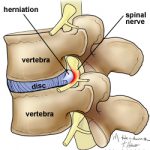As a Neuromuscular Therapist, how did I think about the case of Sally S.? Four things have happened that I take an interest in.

First is the structural imbalance in her back that existed long before the pain started. Muscles that have become dysfunctional from working too hard trying to straighten the spine need to be brought back to health. When Trigger Points have developed in those muscles, hyperactive spots must be treated to prevent continuation of the referred pain patterns typical in this woman.
The second thing of interest is the actual  spinal nerve involvement. When a nerve gets irritated it sends signals out into the muscles along its pathway. Pressure on the nerve can be eliminated by releasing the tension on the muscles that are moving the vertebrae and holding them together. The disc can resume its natural position within the confines of the bones when the tension squeezing the bones together is released.
spinal nerve involvement. When a nerve gets irritated it sends signals out into the muscles along its pathway. Pressure on the nerve can be eliminated by releasing the tension on the muscles that are moving the vertebrae and holding them together. The disc can resume its natural position within the confines of the bones when the tension squeezing the bones together is released.
Third, continued irritation of these muscles can cause local muscle inflammation, formation of other Trigger Points, entrapment of nerves, and resulting muscle dysfunction that can continue long after the source of the excitation in the spine has been removed. These muscles need to be treated locally.

Fourth, scar tissue from the surgery can bind muscles and nerves, restricting normal movement. Stretching and softening the scar tissue reduces its binding effect on the involved tissues
Five goals then might be :
- Try to reduce the severity of the scoliosis with a heel or butt lift.
- Treat Trigger Point sources of pain.
- Treat the muscles of the spine to release tension on the discs,
- Heal local muscles inflamed by nerve or trigger point irritation.
- Soften and stretch the scar tissue.